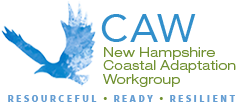
caw projects & community outcomes database
THE PURPOSE OF THE CAW DATABASE IS TO CAPTURE:
- basic project information for all CAW-related projects over time, in order to support needs related to reporting and communicating about CAW’s efforts
- community outcomes, in order to support evaluation and communication of CAW’s impacts and tracking of communities’ adaptation progress over time
The CAW Database is hosted on Airtable and managed by NH Sea Grant Extension. Anyone can submit data via the forms below and view/download data as well. If you need certain reports pulled or direct access to the data, or if you need to edit/delete any data, contact lisa.wise@unh.edu. NH Sea Grant Extension will download the data on a monthly basis as a backup.
CAW Projects
in funding
community outcomes
1. ENTER DATA
instructions
Data are entered through two forms: A) Project Information and B) Community Outcomes. Click on either header below to access the form and enter data. Check to see what information about the project already exists (see Section 2 – View & Explore Data).
a) project information
Project information can be entered at the beginning of a project (preferred), with additional information submitted as needed (e.g., when products are developed). The Airtable form should be embedded below, but you can also access it at this link: https://airtable.com/shrQtIKjEypw5Bq1I.
B) Community outcomes
Community outcomes may be entered as they occur (preferred), or at the end of a project. Select the project with which the outcome is associated, then the community or communities that have achieved the outcome as a result of the project. Multiple outcomes can be entered at a time if the community/communities, outcome year and associated notes are the same. If you need to enter different years and/or notes for different communities, you may submit separate entries. If you select “Other,” please explain the outcome in the notes section. The Airtable Form should be embedded below, but you can also access it at this link: https://airtable.com/shrVFlbZSGhmmZM65.
See Section B1 for the list of community outcomes by category, if needed.
B1 - List of Community Outcomes by Category
BUILDING COMMUNITY CAPACITY OUTCOMES
- Can identify a community climate adaptation champion
- Encourages public participation in climate related decision making
- Engages with other communities
- Engages with other groups within community (watershed orgs, etc.)
- Engages with technical assistance providers (e.g., regional planners) or researchers
- Forms a committee to assist with climate adaptation
- Hires a consultant to assist with a particular project
- Host outreach and education
- Includes funds for adaptive actions in municipal budget
- Increases communication across boards & departments on topic
- Other
- Participates in outreach, education or training
- Recognizes risks based on floodplain maps (or other data)
- Reviews historical records or local knowledge
- Secures municipal funds (bonds, warrant art., grants, etc.)
- Seeks grant funding for adaptation projects
- Seeks specific technical information through CAW and partners
ENGAGES WITH RESEARCH AND ASSESSMENT
- Contributes to a future conditions map
- Contributes to a vulnerability assessment
- Contributes to an economic analysis
- Contributes to mapping of projected conditions (e.g., floodplains)
- Contributes to or conducts surveys or inventories
- Contributes to safe growth audit
- Expands community’s spatial inventory (GIS data)
- Other
- Partners with researchers on a specific project
PLANNING OUTCOMES
- Acknowledges changing climate, effects, and uncertainty in Master Plan
- Adopts higher standards for floodplain management
- Creates adaptation plan
- Identifies desired locations for development to minimize risk
- Identifies protection priorities related to SLR, floodplains, or flood storage
- Modifies hazard mitigation plan to include climate impacts
- Other
- Revises master plan to include climate
- Uses capital improvement plans to prepare financially for impacts on municipal infrastructure
- Uses conservation plan to identify areas important for ecosystem services
REGULATORY OUTCOMES
- Changes zoning requirements to accommodate climate effects (e.g., No Adverse Impact as performance standard)
- Establishes development setbacks
- Establishes non-conforming use provisions for floodplains
- Establishes transfer of development rights based on reducing risks
- Other
- Requires freeboard
- Restricts development or redevelopment in risk-prone areas
- Reviews zoning for climate related concerns
- Zones to create floodplain overlay district
ON-THE-GROUND OUTCOMES
- Conserves land for risk reduction purposes
- Creates floodplain buy-out program
- Designates No Build Zone/Flood Storage Areas (e.g., via easements, purchase or other mechanism)
- Elevates or fortifies critical at-risk public facilities to minimize risk
- Implements a demonstration project related to climate adaptation
- Implements meander easement (riverfront)
- Implements rolling easement (oceanfront)
- Installs structures to decrease effects of storm surge, flood, etc.
- Makes purchases to increase hazard preparedness (e.g., generators)
- Other
- Protects or restores habitat for ecological services (flood storage, shoreline migration, etc.)
- Relocates municipal services/facilities or retreats from high risk locations
- Replaces or upgrades culverts or related infrastructure
1.1 – Use these forms to add items to any of the dropdown lists in the “Project Information” form above. Please check the dropdown lists first to avoid duplication!
Add a new project to the list
add a principal investigator/project director
add a funding source
add a funding program
add an organization
add a community contact
2. VIEW & explore DATA
SEARCH: Use the magnifying glass in the upper righthand corner to search the data.
FILTER/GROUP/SORT:
- Project Directory examples: filter projects by funding source, sort by start date, group by PI, filter by community engaged
- Project Outcomes examples: group outcomes by project, filter by community, sort by outcome category
You can download the data as a .csv file to open in Excel or another program, or print out your current view (click on the “…” icon to access these options). If you download the data from Airtable, the file will include all the data (i.e. without any filters or groups you’ve applied). If you apply a filter and only want to capture that data, you can select all (command/CTRL A) then copy (command/CTRL C) and paste in a spreadsheet or other document you have open, and you will transfer just the data as you’ve filtered or sorted it.
Please remove any groupings, filters, or sorts you have applied to the view before exiting.
